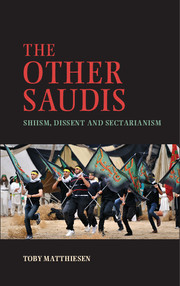Book contents
- Frontmatter
- Dedication
- Contents
- List of Maps and Pictures
- Acknowledgements
- A Note on Conventions
- Glossary
- Abbreviations
- Map
- Introduction
- 1 Politics of Notables
- 2 Oil and Dissent
- 3 Shia Islamism
- 4 A Decade of Confrontation
- 5 No More Revolution
- 6 Marginal Recognition
- 7 A New Intifada
- Conclusion The Politics of Sectarianism
- Bibliography
- Index
- References
2 - Oil and Dissent
Published online by Cambridge University Press: 05 December 2014
- Frontmatter
- Dedication
- Contents
- List of Maps and Pictures
- Acknowledgements
- A Note on Conventions
- Glossary
- Abbreviations
- Map
- Introduction
- 1 Politics of Notables
- 2 Oil and Dissent
- 3 Shia Islamism
- 4 A Decade of Confrontation
- 5 No More Revolution
- 6 Marginal Recognition
- 7 A New Intifada
- Conclusion The Politics of Sectarianism
- Bibliography
- Index
- References
Summary
When I was a kid, Nasser’s pictures were everywhere; I thought he was our king!
Former Saudi opposition activist, Eastern Province, November 2008American companies signed the first oil concession agreement with Saudi Arabia in 1933. The subsequent discovery of oil in 1938 profoundly transformed the lives of the inhabitants of al-Ahsa and Qatif. It led to urbanisation, industrialisation, the disruption of traditional forms of livelihood, the influx of migrant workers and the integration of Saudi Arabia into the American sphere of influence. The agricultural population decreased, as many people saw agriculture as a less profitable source of income. Date production, which was only labour intensive at certain times of the year, lost its dominant position in the economy of the Eastern Province. The date price collapsed between 1948 and 1952, not least because the local population started importing food from abroad. Even though prices slightly recovered after a ban on the export of dates imposed in 1940 was lifted in 1952, this trend could not be reversed.Owning a date garden remained important as a status symbol for notable families but no longer as a main source of economic revenue (see Picture 2.1).
Together with these structural changes, ideas of revolutionary socialism, communism, Arab nationalism and a general sense of anti-colonialism spread to Eastern Arabia. Migrant workers, students returning from abroad, and newspapers filled with Arab nationalist and leftist ideas created the basis for widespread political mobilisation. Radical ideas that had spread beyond the centres of empire in the late nineteenth and early twentieth centuries interacted with the social structures and sectarian make-up of the Gulf. Many of these ideas and publications arrived through the British protectorate island of Bahrain, which had had an earlier tradition of anti-colonial activism and where clandestine networks, civil society organisations, and a radical press flourished since the first half of the twentieth century.
- Type
- Chapter
- Information
- The Other SaudisShiism, Dissent and Sectarianism, pp. 66 - 90Publisher: Cambridge University PressPrint publication year: 2014

